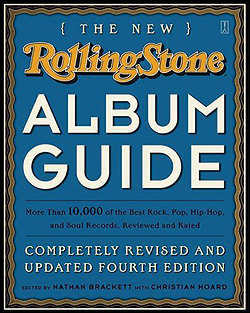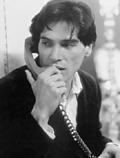When it comes to books about popular music, no format is hardier than the multiwriter anthology. Partly, this is due to the fact that pop is an inherently democratic beast—it’s music as public space, and everyone gets a say. That’s especially true now, with some of the most vibrant writing about pop appearing on blogs and message boards, where questions are debated, ideas are nurtured, and new artists generate word of mouth. (Several of the most heavily hyped artists of the past half-decade, like the Strokes, the Streets, and Dizzee Rascal, have all benefited greatly from Web exposure.) The idea of the rock book as a site for a multiplicity of voices—a kind of idealized, metastasized reviews section, with the stuff under “review” being not just albums but songs, artists, themes, theories—remains a powerful, appealing one for people who like to think about what they’re hearing.
That’s the basic goal behind This Is Pop: In Search of the Elusive at Experience Music Project (Harvard, $19.95), an anthology taken from the inaugural Pop Music Studies Conference held at EMP in April 2002, from which editor Eric Weisbard selected a fairly even spread, spanning the academic (David Sanjek’s “All the Memories Money Can Buy: Marketing Authenticity and Manufacturing Authorship”) to the personal (Sleater-Kinney guitarist-singer Carrie Brownstein’s “More Rock, Less Talk: Live Music Turns Off the Voices in Our Heads”). The best stuff leans toward the latter, often with some wit—the Mountain Goats’ John Darnielle examines hair-metal fans’ online postings, while R.J. Smith details the history of “Open the Door Richard,” a ’40s R&B hit that operated like a meme, infiltrating everyday language before vanishing from the culture at large. Weisbard also contributes a splendid intro that hinges on cult ’80s synth-poppers Book of Love, around whom Weisbard suggests that, like the other figures in the book, the history of pop could be written—more interestingly, maybe, than the artists it traditionally has used.
Weisbard also has a sumptuous chapter on Dolly Parton’s “Down From Dover” in The Rose & the Briar: Death, Love and Liberty in the American Ballad (W.W. Norton, $26.95), edited by Princeton professor Sean Wilentz and Greil Marcus, the author of Mystery Train and The Old Weird America. The idea here is simple: Wilentz and Marcus asked 22 writers to pick a ballad and write about it, with Wilentz contributing a chapter on “Delia” and Marcus writing an envoi; the book is arranged chronologically, according to each ballad’s first appearance. Like This Is Pop, Briar benefits from including some musicians in the mix along with the critics and academics; the Handsome Family’s Rennie Sparks offers a deeply annotated account of “Pretty Polly,” while Pere Ubu’s David Thomas compares and contrasts “The Wreck of the Old 97” and “Dead Man’s Curve,” the Jan and Dean hit from 1964.
Five years after “Curve” first appeared, Marcus penned a straight-faced, very funny review (under the pseudonym T.M. Christian) of an album that didn’t exist: The Masked Marauders, supposedly a secret supersession between Bob Dylan, Mick Jagger, and several Beatles. The review, along with a sour postscript by Marcus, keynotes the second issue of Black Clock (CalArts, $12), in which editor Steve Erickson oversees a bunch of reviews, appreciations, and short stories about albums that exist only in the authors’ imagination. (Right, Black Clock is the twice-yearly journal of CalArts and the MFA Writing Program. But if it looks like a book and is priced like a book, we can certainly refer to it in the same breath as everything else here.) Some of the writers dive in—Sean Howe offers an ode to a collaboration between Al Green and Grace Jones, and Chris Roberts fabricates a Bowie album, Cheap Funk Ocean, complete with an excerpt from a two-star Rolling Stone review—while Jonathan Lethem questions the process of imagining this stuff in “Otis Redding’s Lonely Hearts Club Band.” There are also a half-dozen selections from the Joshua Clover–helmed “Critical Karaoke,” which took place at this year’s EMP Pop Conference. (For more information, see www.calarts.edu/blackclock.)
Speaking of alternate histories, the timeline in the back of Audio Culture: Readings in Modern Music (Continuum, $19.95) might seem alien to anyone who grew up on a steady diet of Rolling Stone‘s canon, most recently (and boringly) demonstrated in the magazine’s list of the rock era’s 500 greatest songs. (Twenty-three by the Beatles, 14 by the Stones, 12 by Dylan, three from 2000 to 2004, thank you and goodnight.) Think of Audio Culture, edited by Christoph Cox and Daniel Warner, as diametrically opposite but no less entrenched; Cox is a regular contributor to the British magazine The Wire, which pumps the stuff covered here like John Cage was John Lennon and Ornette Coleman’s Free Jazz was Sgt. Pepper’s—which isn’t necessarily to say they aren’t, either.
While Audio Culture‘s density is daunting indeed, it’s thorough and engaged, featuring sections on “Noise, Sound, Silence,” listening, minimalism, DJ culture, experimental music, and electronic music. It also features a rich contributors’ list, balancing pieces by critics Simon Reynolds, Philip Sherburne, David Toop, and Kyle Gann, with musicians Michael Nyman, Pauline Oliveros, Brian Eno, and Aphex Twin. Give it to someone you love whose tastes you don’t quite get—and check out its thorough discography for tips on getting yourself started on this stuff, too.
All the Reviews Fit to Print
If you’ve ever wondered which Muddy Waters record to start with, or which Fall releases to avoid—if you’re a pop-music fan—then The New Rolling Stone Album Guide (Fireside, $29.95), updated to include 2004 releases from the likes of Modest Mouse and Franz Ferdinand, will complement your music collection like the latest version of Limewire. Fans of music criticism will enjoy the thorough and entertaining entries, and novices will appreciate the star system. With a few omissions (not a column inch on Metallica or Fatboy Slim, guys?), this compendium of over 10,000 recorded works sorts Billie Holiday to Britney Spears and everything in between. Like a number of A- to-Z guides overcrowding the pop marketplace, canonized material is retread more than its share (five stars for London Calling and Sgt. Pepper’s are no-brainers). But the real meat here lies in digging through discography cracks and uncovering everything from import selections and greatest-hits collections to reviews of the Pulp Fiction and Rushmore soundtracks. This guide is your most knowledgeable, pop-starved friend; chewing your ear about Can’s great, lost Delay 1968 and Insane Clown Posse’s Bizaar, which it says here is no better than Bizzar—who knew? After all, somebody’s gotta listen to all those Fall records so you don’t have to.
Kate Silver








